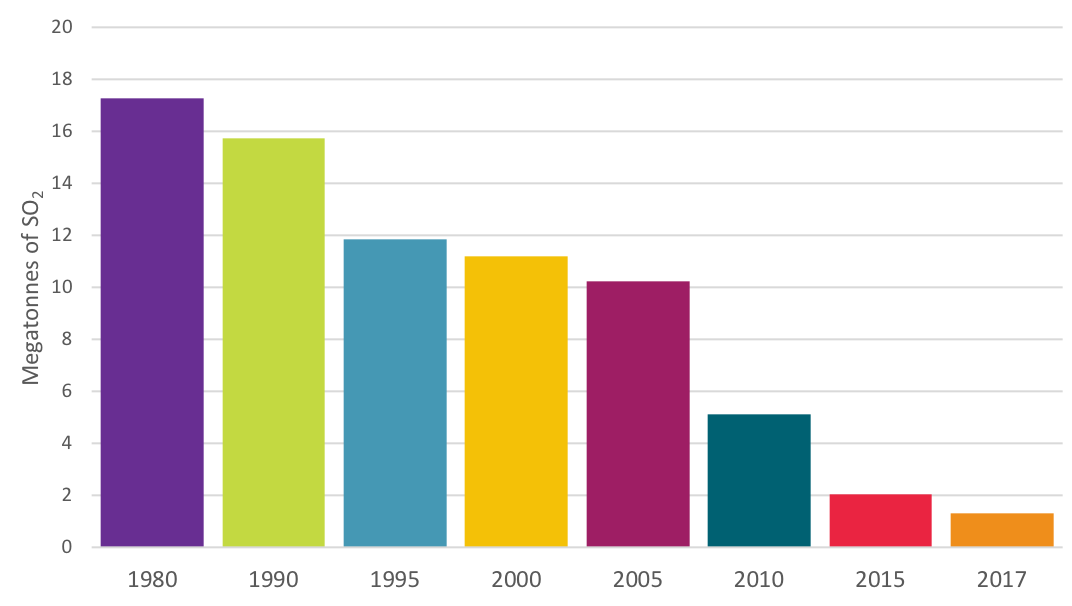
Never forget about acid rain
We don’t hear about acid rain much anymore—at least not in this part of the world. But the term still resonates. It was one of the first environmental issues to capture the public’s attention. I distinctly recall hearing how acid rain could chew through your bicycle or your house on the playground as a kid. I figured I’d encounter it daily as an adult, along with quicksand and killer bees.
The schoolyard rumourmongers had it partially right. Acid rain was a significant environmental threat. It sterilized lakes, stunted crops, and corroded buildings to the tune of tens of billions of dollars. It also didn’t go away on its own.
In 2019, as Canada stares down the barrel of climate change, it’s worth revisiting the story of how we solved acid rain. Canada and the US were both successful, but used different approaches. This blog looks primarily at the US experience.
Odd origins
Curiously, acid rain was an unintended policy consequence of early EPA regulations. In the 1970s, American power plants responded to new air quality standards by lengthening their smokestacks. Rather than pollute the local environment, operators sent their emissions hundreds of feet into the air where winds could carry them large distances. Eventually, precipitation or gravity returned them to the ground.
By the mid-1980s, the problem was too big to ignore.
A new approach
In 1991, the US and Canada agreed to phase out the main culprit: sulfur dioxide (SO2). The primary source of SO2 was coal-fired electricity, but other fossil power contributed as well.
Canada’s approach was fairly straightforward: “cap” SO2 emissions. In other words, limit the total amount of SO2 that power plants can produce.
The US also capped emissions, with a twist. Power plants had the ability to exchange allowances for the right to emit more or less SO2. It was the world’s first pollution market.
The US “cap” corresponded to the number of allowances held by all producers. They could buy and sell these allowances amongst themselves, or bank them for later use. By 2000 the Acid Rain Program (ARP) covered almost every electricity producer in the contiguous United States, over 3,200 facilities.
Exceeding expectations
The ARP outperformed its targets. By 2005, SO2 emissions had declined 36 percent, even as coal production rose 25 percent.
Figure 1: SO2 Emissions from facilities covered by ARP and Cross-State Air Pollution Rule (CSAPR)
Source: EPA, 2019
We can glean three key lessons here.
Lesson #1: It wasn’t costless
SO2 pollution appeared on the balance sheet of every US power plant. Most allowances were assigned for free at auctions based on historical plant performance and initially traded at $137 per tonne of SO2. Prices fluctuated over time, and were occasionally influenced by other EPA regulations (see CAIR below).
Figure 2: ARP Allowance Prices and Influence of Clean Air Interstate Rule (CAIR)

Source: US EPA, 2005
Several pre-implementation estimates placed the ARP’s total costs between $2.5 billion and $6 billion per year.
Lesson #2: It cost less than expected
Early estimates were overestimates. Newer analyses looking at the ARP’s actual performance show that annual program costs varied between $500 million and $3 billion.
Why did the ARP cost less than expected? There are three key reasons.
First, the market-based approach created flexibility and predictability for producers. If it was cheaper to reduce emissions than buy additional allowances, power plants could restructure their operations. If reducing SO2 emissions was prohibitively expensive, plants could buy additional allowances from their competitors. A conservative calculation found the ARP was 16 to 25 percent cheaper than a “command-and-control” approach would have been. That’s between $150 and $270 million a year.
Second, producers got used to the market, and did so pretty quickly. Another study found allowance trading saved between $700 and $800 million annually over the long run. Trade volumes increased fivefold between Year 1 and Year 4, bringing costs down further.
Third, producers innovated. They experimented with different coal mixes, rerouted rail cars to improve access to low-sulfur coal, and invested in scrubbers that removed SO2 before it left the smokestack. Scrubbing in particular proved less expensive than expected—40 percent below early estimates.
Lesson #3: The benefits far outweighed the costs
A widely-cited study calculated the ARP would deliver annual health benefits of $160 billion in the US and $9.5 billion in Canada by 2010. Over 90 percent of these benefits came from reduced mortality, which justified the ARP on their own.
Another study suggests the ecosystem benefits were $1.1 billion per year in the US (current USD). Stacked against the health benefits, the ecosystem benefits were modest, even though they were the original rationale for the policy.
Climate parallels
The parallels between SO2 (acid rain) and greenhouse gases (climate change) aren’t perfect. But they’re still instructive. The costs of dealing with acid rain, while real, were both overstated and positively dwarfed by the benefits. Moreover, many of the benefits came from unexpected places.
Inaction on climate change will cost orders of magnitude more than acid rain. The sooner we get a handle on greenhouse gas emissions, the quicker we accelerate the development of low-carbon technologies, the more effective our efforts to slow climate change will be. To start, we can commit to a price on carbon the same way the US priced SO2.
The story of acid rain is a story of the power of markets. Putting a price on pollution, any kind of pollution, can work. It’s a lesson worth remembering.





1 comment
Brilliant article. I’ll remind every politician I see of that.
Comments are closed.